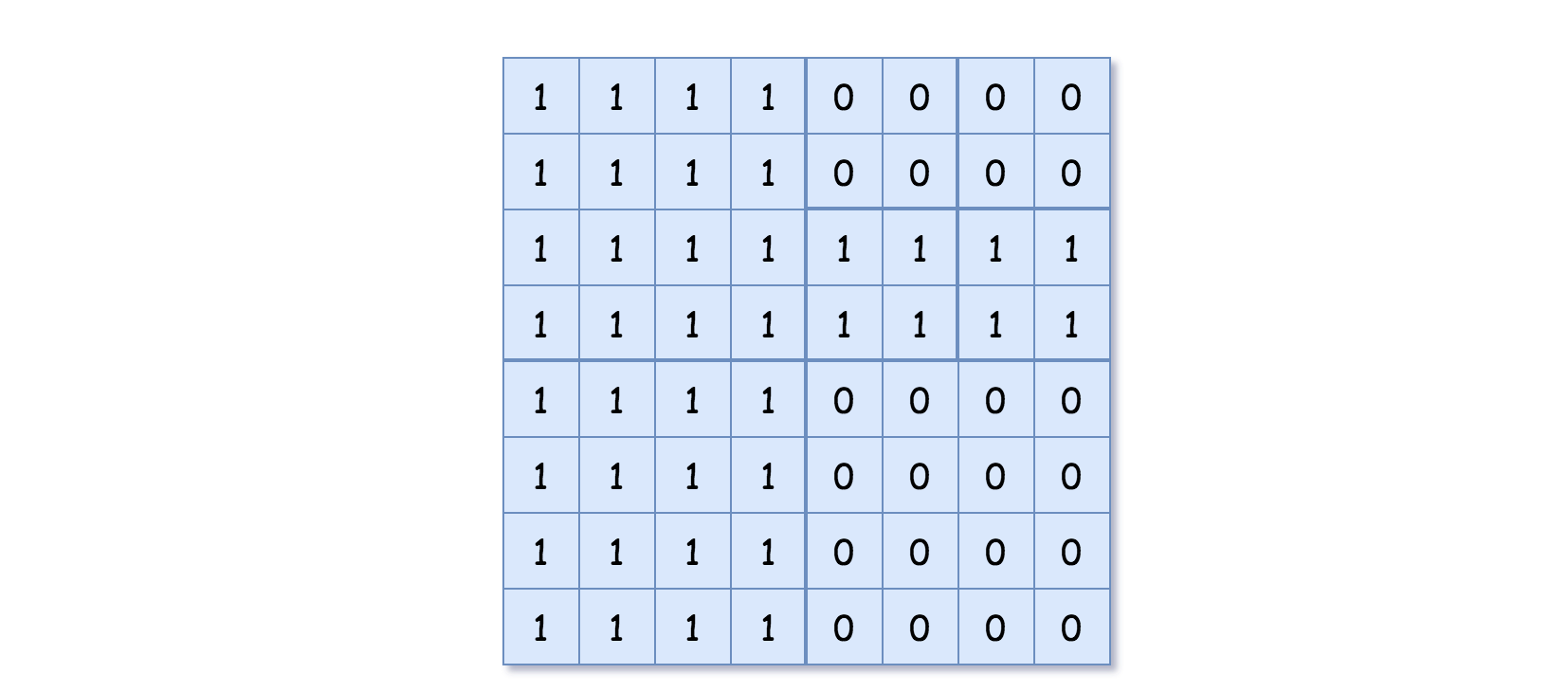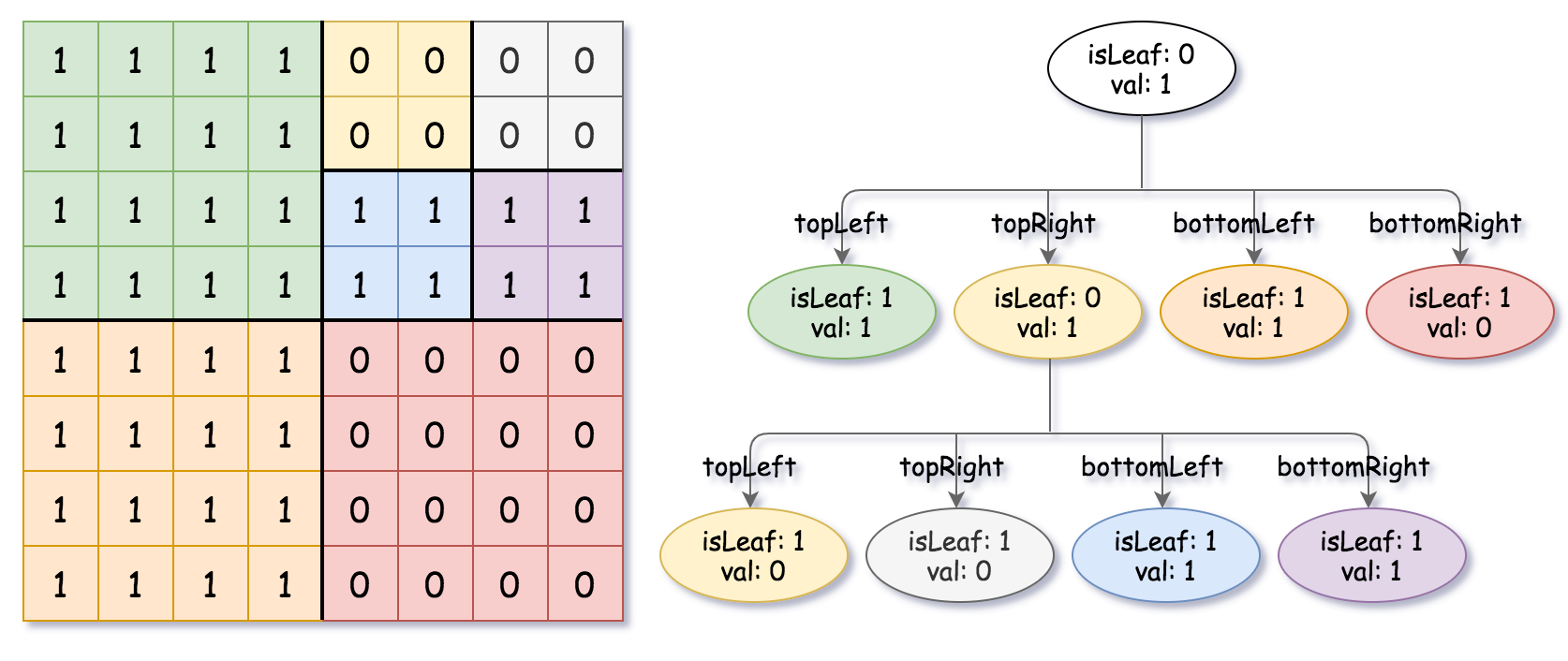
题目描述
给你一个 n * n 矩阵 grid ,矩阵由若干 0 和 1 组成。请你用四叉树表示该矩阵 grid 。
你需要返回能表示矩阵 grid 的 四叉树 的根结点。
四叉树数据结构中,每个内部节点只有四个子节点。此外,每个节点都有两个属性:
val:储存叶子结点所代表的区域的值。1 对应 True,0 对应 False。注意,当 isLeaf 为 False 时,你可以把 True 或者 False 赋值给节点,两种值都会被判题机制 接受 。isLeaf: 当这个节点是一个叶子结点时为 True,如果它有 4 个子节点则为 False 。
class Node {
public boolean val;
public boolean isLeaf;
public Node topLeft;
public Node topRight;
public Node bottomLeft;
public Node bottomRight;
}
我们可以按以下步骤为二维区域构建四叉树:
- 如果当前网格的值相同(即,全为
0 或者全为 1),将 isLeaf 设为 True ,将 val 设为网格相应的值,并将四个子节点都设为 Null 然后停止。
- 如果当前网格的值不同,将
isLeaf 设为 False, 将 val 设为任意值,然后如下图所示,将当前网格划分为四个子网格。
- 使用适当的子网格递归每个子节点。

如果你想了解更多关于四叉树的内容,可以参考 wiki 。
四叉树格式:
你不需要阅读本节来解决这个问题。只有当你想了解输出格式时才会这样做。输出为使用层序遍历后四叉树的序列化形式,其中 null 表示路径终止符,其下面不存在节点。
它与二叉树的序列化非常相似。唯一的区别是节点以列表形式表示 [isLeaf, val] 。
如果 isLeaf 或者 val 的值为 True ,则表示它在列表 [isLeaf, val] 中的值为 1 ;如果 isLeaf 或者 val 的值为 False ,则表示值为 0 。
示例 1:

输入:grid = [[0,1],[1,0]]
输出:[[0,1],[1,0],[1,1],[1,1],[1,0]]
解释:此示例的解释如下:
请注意,在下面四叉树的图示中,0 表示 false,1 表示 True 。

示例 2:

输入:grid = [[1,1,1,1,0,0,0,0],[1,1,1,1,0,0,0,0],[1,1,1,1,1,1,1,1],[1,1,1,1,1,1,1,1],[1,1,1,1,0,0,0,0],[1,1,1,1,0,0,0,0],[1,1,1,1,0,0,0,0],[1,1,1,1,0,0,0,0]]
输出:[[0,1],[1,1],[0,1],[1,1],[1,0],null,null,null,null,[1,0],[1,0],[1,1],[1,1]]
解释:网格中的所有值都不相同。我们将网格划分为四个子网格。
topLeft,bottomLeft 和 bottomRight 均具有相同的值。
topRight 具有不同的值,因此我们将其再分为 4 个子网格,这样每个子网格都具有相同的值。
解释如下图所示:

提示:
n == grid.length == grid[i].lengthn == 2x 其中 0 <= x <= 6
解法
方法一:DFS
DFS 递归遍历 grid,先判断 grid 是否为叶子节点,是则返回叶子节点相关信息;否则递归 grid 4 个子节点。
1
2
3
4
5
6
7
8
9
10
11
12
13
14
15
16
17
18
19
20
21
22
23
24
25
26
27
28
29
30
31
32
33
34 | """
# Definition for a QuadTree node.
class Node:
def __init__(self, val, isLeaf, topLeft, topRight, bottomLeft, bottomRight):
self.val = val
self.isLeaf = isLeaf
self.topLeft = topLeft
self.topRight = topRight
self.bottomLeft = bottomLeft
self.bottomRight = bottomRight
"""
class Solution:
def construct(self, grid: List[List[int]]) -> 'Node':
def dfs(a, b, c, d):
zero = one = 0
for i in range(a, c + 1):
for j in range(b, d + 1):
if grid[i][j] == 0:
zero = 1
else:
one = 1
isLeaf = zero + one == 1
val = isLeaf and one
if isLeaf:
return Node(grid[a][b], True)
topLeft = dfs(a, b, (a + c) // 2, (b + d) // 2)
topRight = dfs(a, (b + d) // 2 + 1, (a + c) // 2, d)
bottomLeft = dfs((a + c) // 2 + 1, b, c, (b + d) // 2)
bottomRight = dfs((a + c) // 2 + 1, (b + d) // 2 + 1, c, d)
return Node(val, isLeaf, topLeft, topRight, bottomLeft, bottomRight)
return dfs(0, 0, len(grid) - 1, len(grid[0]) - 1)
|
1
2
3
4
5
6
7
8
9
10
11
12
13
14
15
16
17
18
19
20
21
22
23
24
25
26
27
28
29
30
31
32
33
34
35
36
37
38
39
40
41
42
43
44
45
46
47
48
49
50
51
52
53
54
55
56
57
58
59
60
61
62
63
64
65 | /*
// Definition for a QuadTree node.
class Node {
public boolean val;
public boolean isLeaf;
public Node topLeft;
public Node topRight;
public Node bottomLeft;
public Node bottomRight;
public Node() {
this.val = false;
this.isLeaf = false;
this.topLeft = null;
this.topRight = null;
this.bottomLeft = null;
this.bottomRight = null;
}
public Node(boolean val, boolean isLeaf) {
this.val = val;
this.isLeaf = isLeaf;
this.topLeft = null;
this.topRight = null;
this.bottomLeft = null;
this.bottomRight = null;
}
public Node(boolean val, boolean isLeaf, Node topLeft, Node topRight, Node bottomLeft, Node
bottomRight) { this.val = val; this.isLeaf = isLeaf; this.topLeft = topLeft; this.topRight =
topRight; this.bottomLeft = bottomLeft; this.bottomRight = bottomRight;
}
};
*/
class Solution {
public Node construct(int[][] grid) {
return dfs(0, 0, grid.length - 1, grid[0].length - 1, grid);
}
private Node dfs(int a, int b, int c, int d, int[][] grid) {
int zero = 0, one = 0;
for (int i = a; i <= c; ++i) {
for (int j = b; j <= d; ++j) {
if (grid[i][j] == 0) {
zero = 1;
} else {
one = 1;
}
}
}
boolean isLeaf = zero + one == 1;
boolean val = isLeaf && one == 1;
Node node = new Node(val, isLeaf);
if (isLeaf) {
return node;
}
node.topLeft = dfs(a, b, (a + c) / 2, (b + d) / 2, grid);
node.topRight = dfs(a, (b + d) / 2 + 1, (a + c) / 2, d, grid);
node.bottomLeft = dfs((a + c) / 2 + 1, b, c, (b + d) / 2, grid);
node.bottomRight = dfs((a + c) / 2 + 1, (b + d) / 2 + 1, c, d, grid);
return node;
}
}
|
1
2
3
4
5
6
7
8
9
10
11
12
13
14
15
16
17
18
19
20
21
22
23
24
25
26
27
28
29
30
31
32
33
34
35
36
37
38
39
40
41
42
43
44
45
46
47
48
49
50
51
52
53
54
55
56
57
58
59
60
61
62
63
64
65
66
67 | /*
// Definition for a QuadTree node.
class Node {
public:
bool val;
bool isLeaf;
Node* topLeft;
Node* topRight;
Node* bottomLeft;
Node* bottomRight;
Node() {
val = false;
isLeaf = false;
topLeft = NULL;
topRight = NULL;
bottomLeft = NULL;
bottomRight = NULL;
}
Node(bool _val, bool _isLeaf) {
val = _val;
isLeaf = _isLeaf;
topLeft = NULL;
topRight = NULL;
bottomLeft = NULL;
bottomRight = NULL;
}
Node(bool _val, bool _isLeaf, Node* _topLeft, Node* _topRight, Node* _bottomLeft, Node* _bottomRight) {
val = _val;
isLeaf = _isLeaf;
topLeft = _topLeft;
topRight = _topRight;
bottomLeft = _bottomLeft;
bottomRight = _bottomRight;
}
};
*/
class Solution {
public:
Node* construct(vector<vector<int>>& grid) {
return dfs(0, 0, grid.size() - 1, grid[0].size() - 1, grid);
}
Node* dfs(int a, int b, int c, int d, vector<vector<int>>& grid) {
int zero = 0, one = 0;
for (int i = a; i <= c; ++i) {
for (int j = b; j <= d; ++j) {
if (grid[i][j])
one = 1;
else
zero = 1;
}
}
bool isLeaf = zero + one == 1;
bool val = isLeaf && one;
Node* node = new Node(val, isLeaf);
if (isLeaf) return node;
node->topLeft = dfs(a, b, (a + c) / 2, (b + d) / 2, grid);
node->topRight = dfs(a, (b + d) / 2 + 1, (a + c) / 2, d, grid);
node->bottomLeft = dfs((a + c) / 2 + 1, b, c, (b + d) / 2, grid);
node->bottomRight = dfs((a + c) / 2 + 1, (b + d) / 2 + 1, c, d, grid);
return node;
}
};
|
1
2
3
4
5
6
7
8
9
10
11
12
13
14
15
16
17
18
19
20
21
22
23
24
25
26
27
28
29
30
31
32
33
34
35
36
37
38
39 | /**
* Definition for a QuadTree node.
* type Node struct {
* Val bool
* IsLeaf bool
* TopLeft *Node
* TopRight *Node
* BottomLeft *Node
* BottomRight *Node
* }
*/
func construct(grid [][]int) *Node {
var dfs func(a, b, c, d int) *Node
dfs = func(a, b, c, d int) *Node {
zero, one := 0, 0
for i := a; i <= c; i++ {
for j := b; j <= d; j++ {
if grid[i][j] == 0 {
zero = 1
} else {
one = 1
}
}
}
isLeaf := zero+one == 1
val := isLeaf && one == 1
node := &Node{Val: val, IsLeaf: isLeaf}
if isLeaf {
return node
}
node.TopLeft = dfs(a, b, (a+c)/2, (b+d)/2)
node.TopRight = dfs(a, (b+d)/2+1, (a+c)/2, d)
node.BottomLeft = dfs((a+c)/2+1, b, c, (b+d)/2)
node.BottomRight = dfs((a+c)/2+1, (b+d)/2+1, c, d)
return node
}
return dfs(0, 0, len(grid)-1, len(grid[0])-1)
}
|





